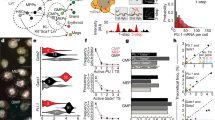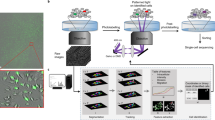Abstract
Continuous long-term single-cell observation provides insight into the molecular control of cell fate. This is particularly important for rare and heterogeneous populations of cells, such as mammalian stem cells. The current lack of usable off-the-shelf hardware and software for such experiments makes their implementation technically challenging. Here I discuss the need for continuous single-cell quantification to understand molecular cell fate control as well as organizational and technical solutions for long-term imaging and tracking of stem cells.
This is a preview of subscription content, access via your institution
Access options
Subscribe to this journal
Receive 12 print issues and online access
$259.00 per year
only $21.58 per issue
Buy this article
- Purchase on Springer Link
- Instant access to full article PDF
Prices may be subject to local taxes which are calculated during checkout



Similar content being viewed by others
References
Barker, N. et al. Lgr5(+ve) stem cells drive self-renewal in the stomach and build long-lived gastric units in vitro. Cell Stem Cell 6, 25–36 (2010).
Barker, N. et al. Identification of stem cells in small intestine and colon by marker gene Lgr5. Nature 449, 1003–1007 (2007).
Benveniste, P. et al. Intermediate-term hematopoietic stem cells with extended but time-limited reconstitution potential. Cell Stem Cell 6, 48–58 (2010).
Kiel, M.J. et al. SLAM family receptors distinguish hematopoietic stem and progenitor cells and reveal endothelial niches for stem cells. Cell 121, 1109–1121 (2005).
Osawa, M., Hanada, K., Hamada, H. & Nakauchi, H. Long-term lymphohematopoietic reconstitution by a single CD34-low/negative hematopoietic stem cell. Science 273, 242–245 (1996).
Shackleton, M. et al. Generation of a functional mammary gland from a single stem cell. Nature 439, 84–88 (2006).
Stingl, J. et al. Purification and unique properties of mammary epithelial stem cells. Nature 439, 993–997 (2006).
Dykstra, B. et al. Long-term propagation of distinct hematopoietic differentiation programs in vivo. Cell Stem Cell 1, 218–229 (2007).
Lemischka, I.R., Raulet, D.H. & Mulligan, R.C. Developmental potential and dynamic behavior of hematopoietic stem cells. Cell 45, 917–927 (1986).
Schroeder, T. Hematopoietic stem cell heterogeneity: subtypes, not unpredictable behavior. Cell Stem Cell 6, 203–207 (2010).
Chang, H.H., Hemberg, M., Barahona, M., Ingber, D.E. & Huang, S. Transcriptome-wide noise controls lineage choice in mammalian progenitor cells. Nature 453, 544–547 (2008).
Cross, M.A. et al. Expression of lineage restricted transcription factors precedes lineage specific differentiation in a multipotent haemopoietic progenitor cell line. Oncogene 9, 3013–3016 (1994).
Graf, T. & Enver, T. Forcing cells to change lineages. Nature 462, 587–594 (2009).
Chambers, I. et al. Nanog safeguards pluripotency and mediates germline development. Nature 450, 1230–1234 (2007).
Huang, S. Non-genetic heterogeneity of cells in development: more than just noise. Development 136, 3853–3862 (2009).
Spiller, D.G., Wood, C.D., Rand, D.A. & White, M.R. Measurement of single-cell dynamics. Nature 465, 736–745 (2010).
Rieger, M.A. & Schroeder, T. Exploring hematopoiesis at single cell resolution. Cells Tissues Organs 188, 139–149 (2008).
Schroeder, T. Tracking hematopoiesis at the single cell level. Ann. NY Acad. Sci. 1044, 201–209 (2005).
Schroeder, T. Imaging stem-cell-driven regeneration in mammals. Nature 453, 345–351 (2008).
Schroeder, T. The electronic crystal ball: predicting cell fate from time-lapse data. Nat. Methods 7, 190–191 (2010).
Eilken, H.M., Nishikawa, S. & Schroeder, T. Continuous single-cell imaging of blood generation from haemogenic endothelium. Nature 457, 896–900 (2009).
Rieger, M.A., Hoppe, P.S., Smejkal, B.M., Eitelhuber, A.C. & Schroeder, T. Hematopoietic cytokines can instruct lineage choice. Science 325, 217–218 (2009).
Megason, S.G. & Fraser, S.E. Imaging in systems biology. Cell 130, 784–795 (2007).
Rieger, M.A. & Schroeder, T. Analyzing cell fate control by cytokines through continuous single cell biochemistry. J. Cell. Biochem. 108, 343–352 (2009).
Baker, M. Cellular imaging: taking a long, hard look. Nature 466, 1137–1140 (2010).
Cohen, A.R., Gomez, F.L.A., Roysam, B. & Cayouette, M. Computational prediction of neural progenitor cell fates. Nat. Methods 7, 213–218 (2010).
Kuang, S., Kuroda, K., Le Grand, F. & Rudnicki, M.A. Asymmetric self-renewal and commitment of satellite stem cells in muscle. Cell 129, 999–1010 (2007).
Costa, M. et al. Continuous live imaging of adult neural stem cell division and lineage progression in vitro. Development 138, 1057–1068 (2011).
Costa, M.R., Bucholz, O., Schroeder, T. & Gotz, M. Late origin of glia-restricted progenitors in the developing mouse cerebral cortex. Cereb. Cortex 19 Suppl 1, i135–i143 (2009).
Dykstra, B. et al. High-resolution video monitoring of hematopoietic stem cells cultured in single-cell arrays identifies new features of self-renewal. Proc. Natl. Acad. Sci. USA 103, 8185–8190 (2006).
Shen, Q. et al. The timing of cortical neurogenesis is encoded within lineages of individual progenitor cells. Nat. Neurosci. 9, 743–751 (2006).
Costa, M.R., Wen, G., Lepier, A., Schroeder, T. & Gotz, M. Par-complex proteins promote proliferative progenitor divisions in the developing mouse cerebral cortex. Development 135, 11–22 (2008).
Kimura, A. et al. The transcription factors STAT5A/B regulate GM-CSF-mediated granulopoiesis. Blood 114, 4721–4728 (2009).
Ravin, R. et al. Potency and fate specification in CNS stem cell populations in vitro. Cell Stem Cell 3, 670–680 (2008).
Berninger, B. et al. Functional properties of neurons derived from in vitro reprogrammed postnatal astroglia. J. Neurosci. 27, 8654–8664 (2007).
Heinrich, C. et al. Directing astroglia from the cerebral cortex into subtype specific functional neurons. PLoS Biol. 8, e1000373 (2010).
Heinrich, C. et al. Generation of subtype specific neurons from postnatal astroglia of the mouse cerebral cortex. Nat. Protoc. 6, 214–228 (2011).
Warlich, E. et al. Lentiviral vector design and imaging approaches to visualize the early stages of cellular reprogramming. Mol. Ther. advance online publication, doi:10.1038/mt.2010.314 (1 February 2011).
Ntziachristos, V. Going deeper than microscopy: the optical imaging frontier in biology. Nat. Methods 7, 603–614 (2010).
Tsien, R.Y. Imagining imaging's future. Nat. Rev. Mol. Cell Biol. 4 (suppl.), SS16–SS21 (2003).
Stadtfeld, M., Varas, F. & Graf, T. Fluorescent protein-cell labeling and its application in time-lapse analysis of hematopoietic differentiation. Methods Mol. Med. 105, 395–412 (2005).
Rothbauer, U. et al. Targeting and tracing antigens in live cells with fluorescent nanobodies. Nat. Methods 3, 887–889 (2006).
Shaner, N.C., Steinbach, P.A. & Tsien, R.Y. A guide to choosing fluorescent proteins. Nat. Methods 2, 905–909 (2005).
Pantazis, P., Maloney, J., Wu, D. & Fraser, S.E. Second harmonic generating (SHG) nanoprobes for in vivo imaging. Proc. Natl. Acad. Sci. USA 107, 14535–14540 (2010).
Eilken, H.M. et al. Continuous long-term detection of live cell surface markers by 'in culture' antibody staining. Protoc. Exchange doi:10.1038/protex.2011.205 (published online 28 January 2011).
Cappello, S. et al. The Rho-GTPase cdc42 regulates neural progenitor fate at the apical surface. Nat. Neurosci. 9, 1099–1107 (2006).
Collins, T.J. ImageJ for microscopy. Biotechniques 43, 25–30 (2007).
Lamprecht, M.R., Sabatini, D.M. & Carpenter, A.E. CellProfiler: free, versatile software for automated biological image analysis. Biotechniques 42, 71–75 (2007).
Macarthur, B.D., Ma'ayan, A. & Lemischka, I.R. Systems biology of stem cell fate and cellular reprogramming. Nat. Rev. Mol. Cell Biol. 10, 672–681 (2009).
Whichard, Z.L., Sarkar, C.A., Kimmel, M. & Corey, S.J. Hematopoiesis and its disorders: a systems biology approach. Blood 115, 2339–2347 (2010).
Acknowledgements
This work was in part financed by the Deutsche Forschungsgemeinschaft.
Author information
Authors and Affiliations
Corresponding author
Ethics declarations
Competing interests
The author declares no competing financial interests.
Rights and permissions
About this article
Cite this article
Schroeder, T. Long-term single-cell imaging of mammalian stem cells. Nat Methods 8 (Suppl 4), S30–S35 (2011). https://doi.org/10.1038/nmeth.1577
Published:
Issue Date:
DOI: https://doi.org/10.1038/nmeth.1577
This article is cited by
-
Machine learning inference of continuous single-cell state transitions during myoblast differentiation and fusion
Molecular Systems Biology (2024)
-
Machine learning-based classification of dual fluorescence signals reveals muscle stem cell fate transitions in response to regenerative niche factors
npj Regenerative Medicine (2023)
-
Three-dimensional label-free morphology of CD8 + T cells as a sepsis biomarker
Light: Science & Applications (2023)
-
Adaptive optical quantitative phase imaging based on annular illumination Fourier ptychographic microscopy
PhotoniX (2022)
-
Machine learning phenomics (MLP) combining deep learning with time-lapse-microscopy for monitoring colorectal adenocarcinoma cells gene expression and drug-response
Scientific Reports (2022)



